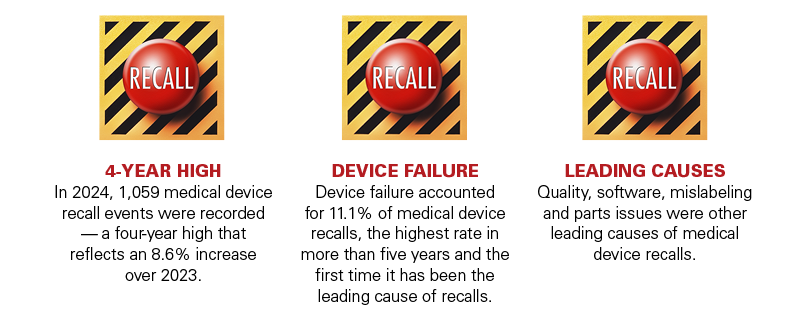4 Steps to Improve Medical Device Recall Tracking
The need to build an effective recall management team in health care is becoming increasingly clear. Consider the recent news that medical device recalls by the Food and Drug Administration reached a four-year high in 2024.
With nearly 11% of these events involving Class 1 recalls, which signals a reasonable probability that using the product could cause harm or death, the data underscore the seriousness of this issue. And early results for 2025 indicate that the rise in Class 1 medical device recalls is continuing.
As of late February, there were 147 medical device recall events and 20 of them, or 13.6%, were Class I, according to a Modern Healthcare report.
Medical Device Recalls by the Numbers
Highlights from the 2025 Product and Safety Regulation Recall Index report from Sedgwick, which offers best practices in product recall and remediation solutions, include:

Reasons for the rising number of medical device recalls vary. A large portion of the increase is due to a higher number of recalls from a small number of manufacturers subject to inspections and/or other actions, an FDA spokesperson told Modern Healthcare. Additionally, manufacturers increasingly are reporting problems and fixing them due to a continued, concerted effort by the FDA to drive greater device safety.
Recalls, whether involving medical devices, pharmaceuticals, food, equipment, vehicles or other defective products, demand prompt, coordinated action to prevent harm to patients and staff, notes Aaron Weinbaum, Vizient’s physical environment adviser for regulatory and accreditation services, in a recent blog.
4 Steps to Build or Improve an Effective Recall Management Team
1 | Establish a formal recall policy.
A comprehensive recall policy is important for standardizing response procedures and ensuring compliance with regulatory guidelines, Weinbaum notes. This policy should include clearly documented protocols that define the steps to be taken during a recall. It also should establish escalation criteria, identifying triggers for various levels of recalls, such as high-risk or routine, and outlining the necessary actions for prompt response.
2 | Define the recall team’s purpose and scope.
The team's primary role is managing the hospital's response to product recalls and vendor notifications. This includes identifying, communicating, removing and replacing recalled items. The team oversees all stages of recall management, from initial notification to final handling. A well-structured recall team ensures compliance with regulations, maintains clear communication with patients and staff and minimizes financial and operational impacts.
3 | Collaborate with external stakeholders.
This is important for effective recall management. Open communication with vendors ensures timely recall alerts and necessary support. Staying up to date on regulatory trends helps providers stay compliant and adapt to changing standards. This proactive approach strengthens recall efforts and reduces risks.
4 | Develop tracking and documentation metrics.
Effective recall management requires systematic tracking and reporting. Providers should document alerts received, resolution times and impacts on patients, staff or inventory, Weinbaum writes. These metrics ensure accountability and identify areas for improvement. Recall management tools streamline efforts by automating notifications, tracking responses and maintaining records for audits. Adopting these practices enhances efficiency and reduces risks.



